|
|
|
| Home > Temple Stay > Temple Stay - Seoul |
|
 |
 |
 |
 |
 |
If you wish to have more information of Korean Templestay,
please send us
e-mail or fax (+82-2-6092-8150).
|
 |
 |
 Jo-gye sa Jo-gye sa |
 |
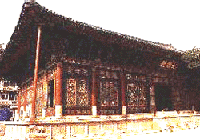 Jo-gye Order emphasizes Seon (Zen) and is representative of 1200 years of Korean Buddhism. Jo-gye sa is one of the main temples of the Jo-gye Order and Korean Buddhism, where Buddhist groups including official organizations gather.Jo-gye sa was established as Jogye Order's headquarter during the Japanese colonial period to carry on the tradition of Korea Buddhism.You can feel the sentiment of a Buddhist temple in the most crowded part of Seoul. Jo-gye Order emphasizes Seon (Zen) and is representative of 1200 years of Korean Buddhism. Jo-gye sa is one of the main temples of the Jo-gye Order and Korean Buddhism, where Buddhist groups including official organizations gather.Jo-gye sa was established as Jogye Order's headquarter during the Japanese colonial period to carry on the tradition of Korea Buddhism.You can feel the sentiment of a Buddhist temple in the most crowded part of Seoul. |
|
 |
 |
 |
 Bong-won sa Bong-won sa |
 |
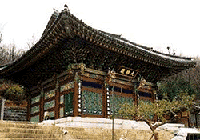 Late in the 9th century, the National Preceptor Dosun built this temple and called it Ban-ya sa. During the period of King Youngjo of the Yi Daynasty, Ban-ya sa was moved to the present site and renamed Bong-won sa. From the beginning of the Yi Dynasty, the kings' portraits were kept in this temple and at the end of the Yi Dynasty, Kim Okgyun, who was one of the leaders of the modernizing movement, stayed at this temple. The Hall of Three Thousand Buddhas is the largest hall in Korea and is famous for not having a single nail used in its construction. The cross beam is from a 227 year old tree from Alaska, and weighs seven tons. In the hall, three thousand Buddhas and the Vairocana Buddha are enshrined. Late in the 9th century, the National Preceptor Dosun built this temple and called it Ban-ya sa. During the period of King Youngjo of the Yi Daynasty, Ban-ya sa was moved to the present site and renamed Bong-won sa. From the beginning of the Yi Dynasty, the kings' portraits were kept in this temple and at the end of the Yi Dynasty, Kim Okgyun, who was one of the leaders of the modernizing movement, stayed at this temple. The Hall of Three Thousand Buddhas is the largest hall in Korea and is famous for not having a single nail used in its construction. The cross beam is from a 227 year old tree from Alaska, and weighs seven tons. In the hall, three thousand Buddhas and the Vairocana Buddha are enshrined. |
|
 |
 |
 |
 Bong-eun sa Bong-eun sa |
 |
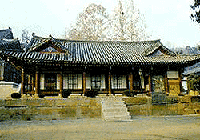 Bong-uen sa is located in the middle of southern Seoul, the core of the Seoul metropolis, but preserves the traditional shape of a Buddhist temple. The Main Dharma Hall in the temple compound makes beautiful harmony with surrounding modern buildings. Bong-uen sa harmonizes past with present, nature with the city, and noise with stillness. Bong-uen sa is located in the middle of southern Seoul, the core of the Seoul metropolis, but preserves the traditional shape of a Buddhist temple. The Main Dharma Hall in the temple compound makes beautiful harmony with surrounding modern buildings. Bong-uen sa harmonizes past with present, nature with the city, and noise with stillness. |
|
 |
 |
 |
 |
 |
 Kwan-mun sa Kwan-mun sa |
 |
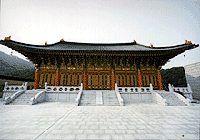 Kwan-mun sa is a seven-story building well harmonized between modern high-technology architecture and its Korean traditional exterior. A statue of Avalokitesvara chiseled out of white gemstone, and three thousand statues of Buddha are enshrined. The Buddha hall is a multipurpose cultural self-discipline room and the three thousand white gem Buddha statues are the pride of Kwan-mun sa. The precincts of Kwan-mun sa contain an exhibition hall of religious treasures for seeing at a glance the cultural heritage of several Asian Buddhist countries such as Korea, China and Tibet. It will be open all through the 2002 World Cup season and will provide an opportunity to access various Asian Buddhist cultures for locals and internationals visiting Kwan-mun sa. Kwan-mun sa is a seven-story building well harmonized between modern high-technology architecture and its Korean traditional exterior. A statue of Avalokitesvara chiseled out of white gemstone, and three thousand statues of Buddha are enshrined. The Buddha hall is a multipurpose cultural self-discipline room and the three thousand white gem Buddha statues are the pride of Kwan-mun sa. The precincts of Kwan-mun sa contain an exhibition hall of religious treasures for seeing at a glance the cultural heritage of several Asian Buddhist countries such as Korea, China and Tibet. It will be open all through the 2002 World Cup season and will provide an opportunity to access various Asian Buddhist cultures for locals and internationals visiting Kwan-mun sa. |
|
 |
 |
 |
 Myo-gak sa Myo-gak sa |
 |
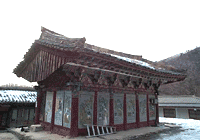 Myo-gak sa is located on Mt. Naksan in Seoul, and was built in 1942. The major Buddhist practice of this temple is the Kwanuem prayer. This temple has the Kwanuem Bodhisattva figure carved on the stone face of a cliff of Mt. Naksan. Myo-gak sa consists of three buildings: the Main Buddha Hall, the residence hall and the stone cave. In the stone cave, the Buddha statue is facing the north, which is a unique posture to pray for unification of North and South Korea, and the wellbeing of North Koreans. According to the Feng-sui theory, building Myo-gak sa on this site brings safety and peace to the city and citizens. Myo-gak sa is located on Mt. Naksan in Seoul, and was built in 1942. The major Buddhist practice of this temple is the Kwanuem prayer. This temple has the Kwanuem Bodhisattva figure carved on the stone face of a cliff of Mt. Naksan. Myo-gak sa consists of three buildings: the Main Buddha Hall, the residence hall and the stone cave. In the stone cave, the Buddha statue is facing the north, which is a unique posture to pray for unification of North and South Korea, and the wellbeing of North Koreans. According to the Feng-sui theory, building Myo-gak sa on this site brings safety and peace to the city and citizens. |
|
 |
 |
 |
 Topjusimindang Topjusimindang |
 |
| As the headquarters of the Jin-gak Order, one of Korean Buddhism's 4 orders, Topjusimindang offers a spacious yet cozy grounds harmonizing a unique temple compound with the landscape in uptown, and there is always the fragrance of clear and purified practice in the air. |
|
 |
 |
 |
 |
 |
If you wish to have more information of Korean Templestay,
please send us
e-mail or fax (+82-2-6092-8150).
|
 |
 |
 |
|
|
|
|
|